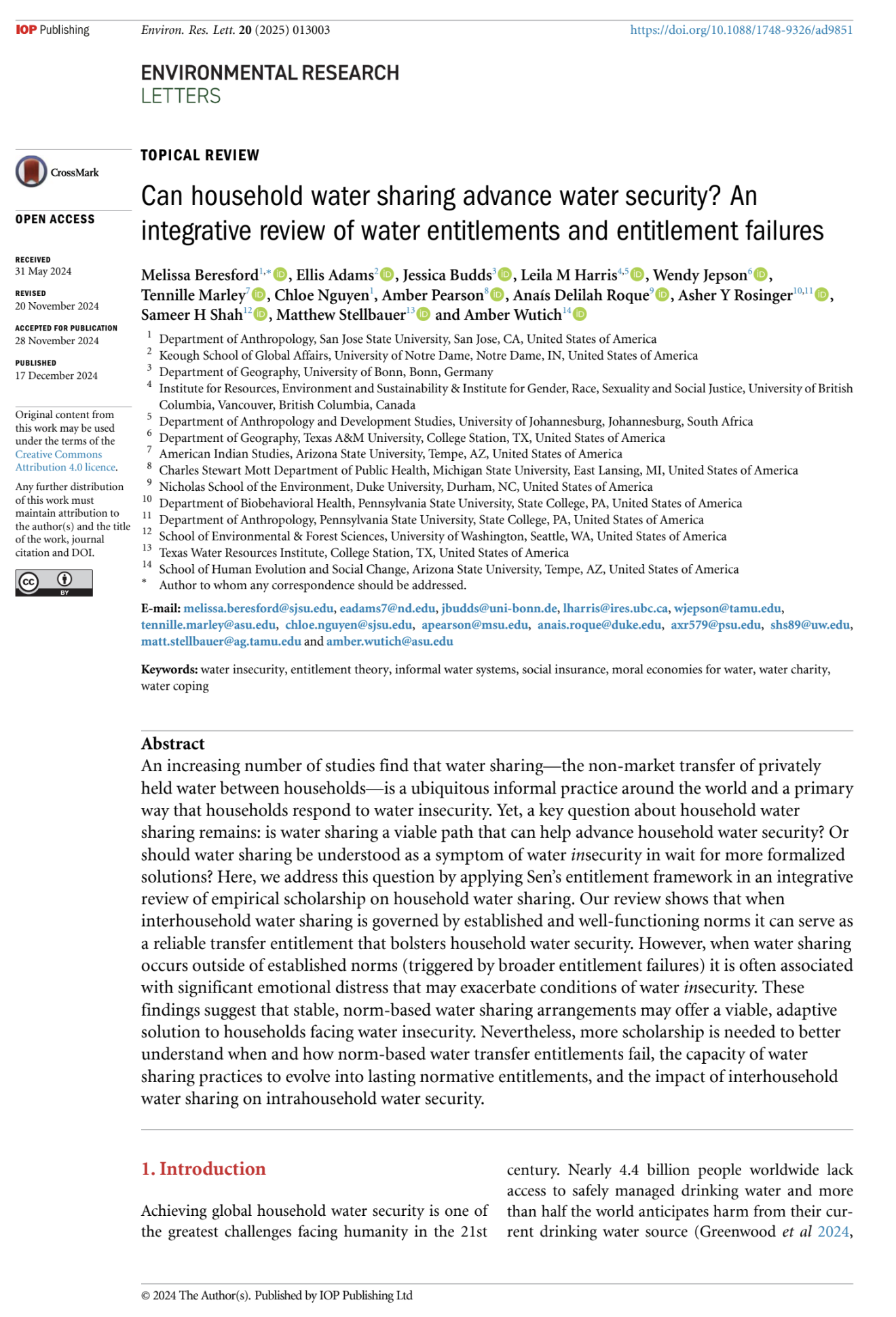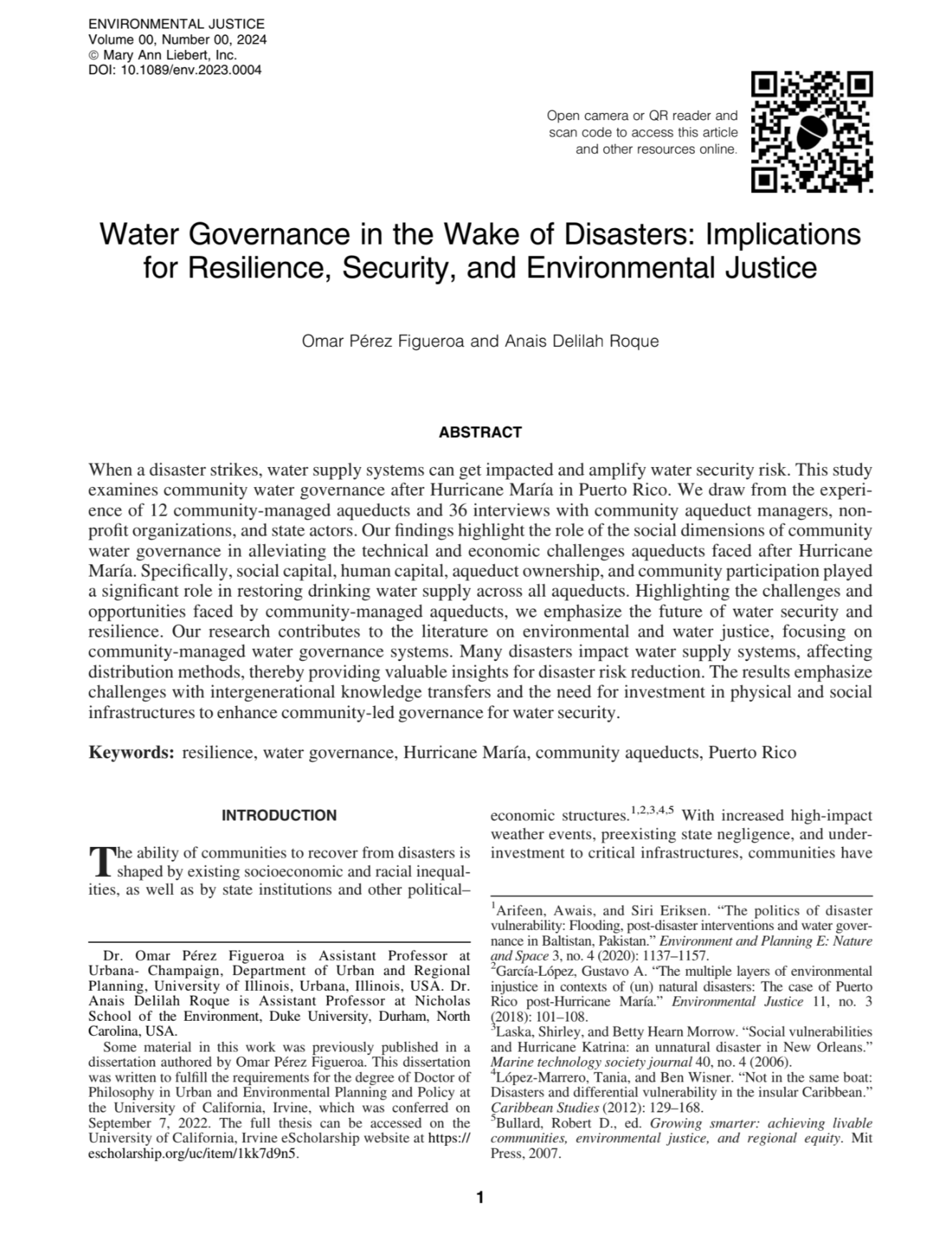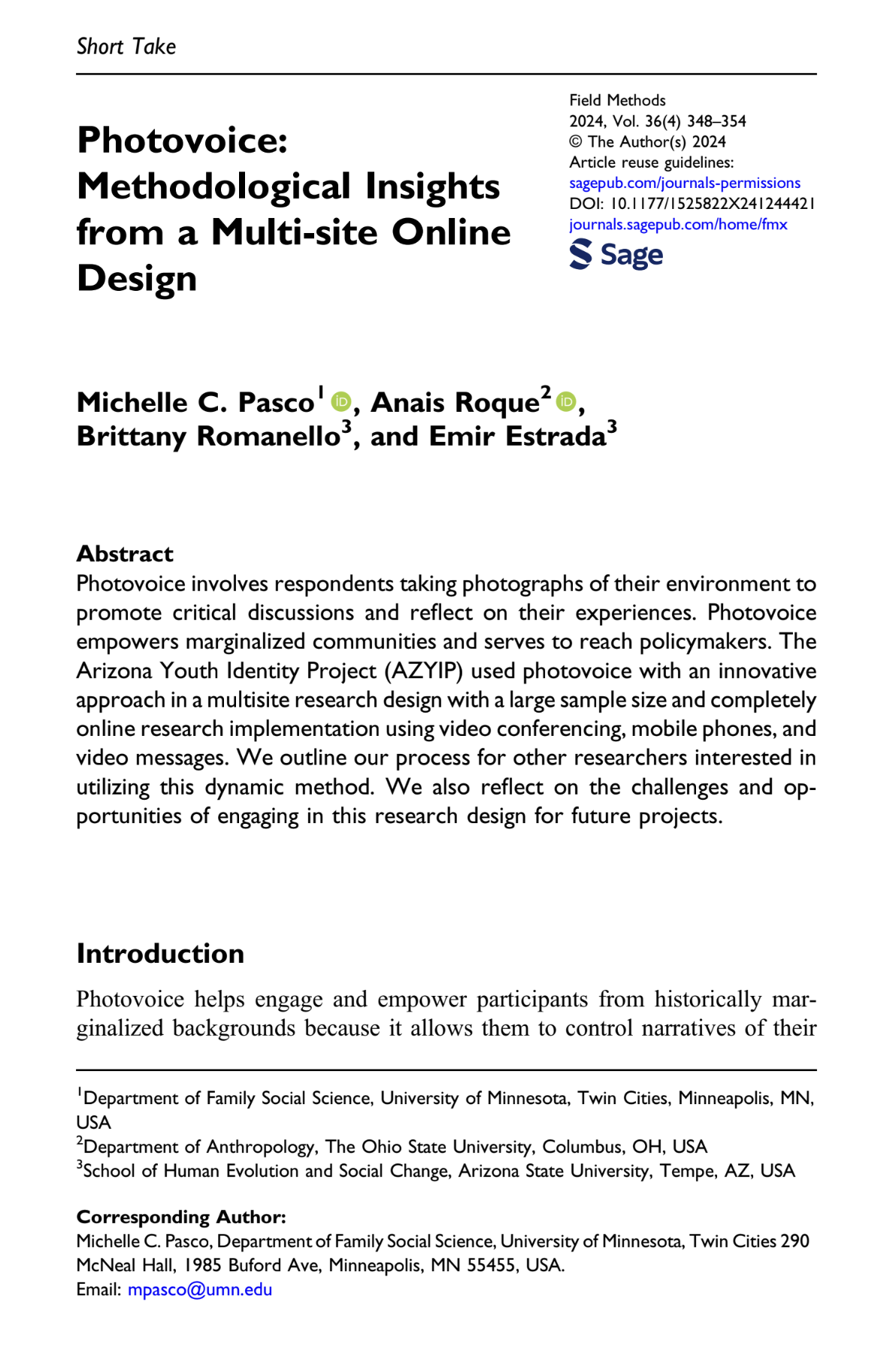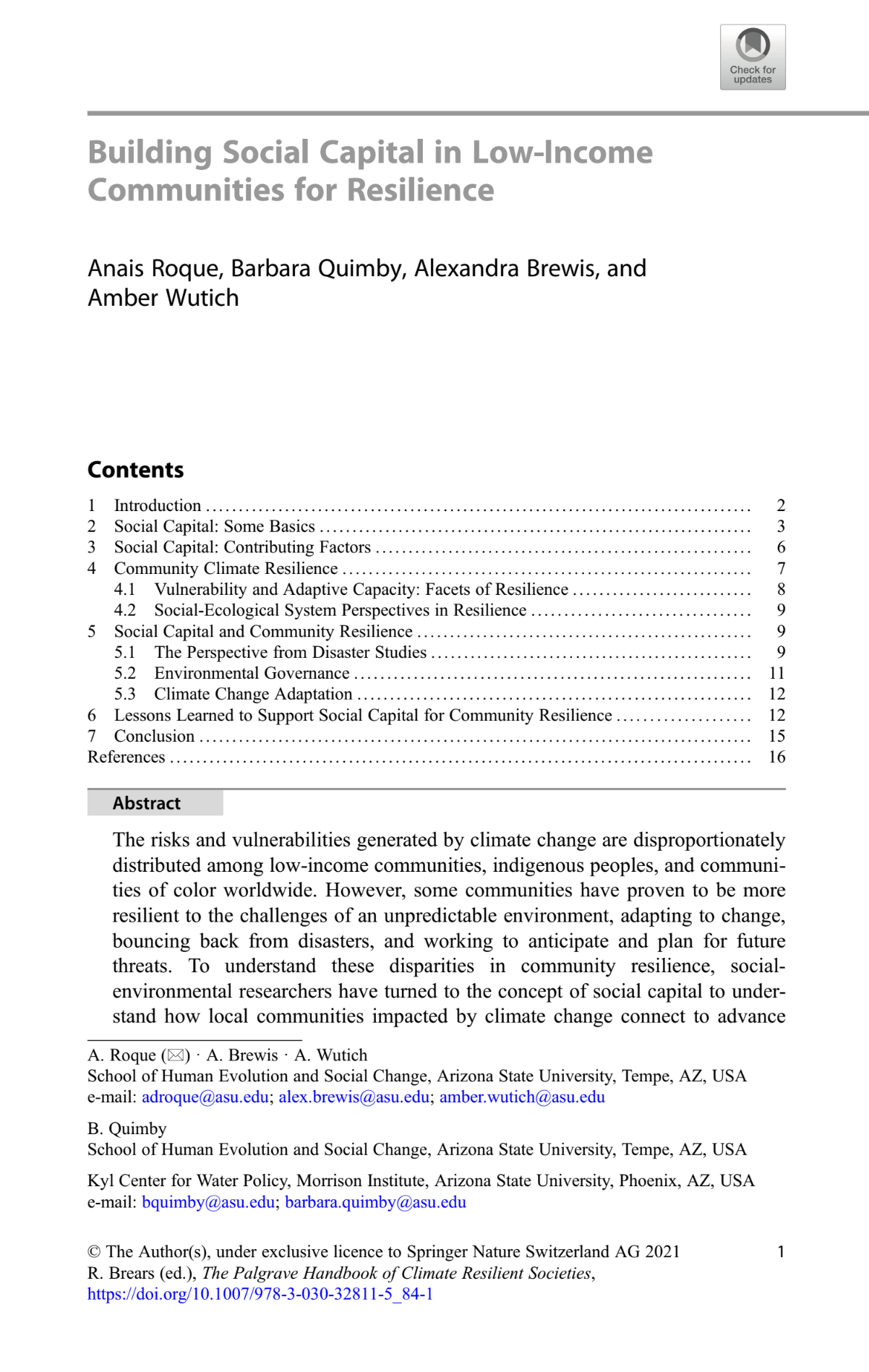Publications
Selected publications, for full list visit Google Scholar.
Beresford, M., Adams, E. A., Budds, J., Harris, L., Jepson, W., Marley, T., Nguyen, C., Pearson, A.L., Roque, A. D., Rosinger, A.Y., Shah, S.H., Stellbauer, M., Wutich, A. (2024).
An increasing number of studies find that water sharing—the non-market transfer of privately held water between households—is a ubiquitous informal practice around the world and a primary way that households respond to water insecurity. Yet, a key question about household water sharing remains: is water sharing a viable path that can help advance household water security? Or should water sharing be understood as a symptom of water insecurity in wait for more formalized solutions? Here, we address this question by applying Sen’s entitlement framework in an integrative review of empirical scholarship on household water sharing. Our review shows that when interhousehold water sharing is governed by established and well-functioning norms it can serve as a reliable transfer entitlement that bolsters household water security. However, when water sharing occurs outside of established norms (triggered by broader entitlement failures) it is often associated with significant emotional distress that may exacerbate conditions of water insecurity. These findings suggest that stable, norm-based water sharing arrangements may offer a viable, adaptive solution to households facing water insecurity. Nevertheless, more scholarship is needed to better understand when and how norm-based water transfer entitlements fail, the capacity of water sharing practices to evolve into lasting normative entitlements, and the impact of interhousehold water sharing on intrahousehold water security.
Omar Pérez Figueroa and Anais Delilah Roque
When a disaster strikes, water supply systems can get impacted and amplify water security risk. This study examines community water governance after Hurricane María in Puerto Rico. We draw from the experience of 12 community-managed aqueducts and 36 interviews with community aqueduct managers, nonprofit organizations, and state actors. Our findings highlight the role of the social dimensions of community water governance in alleviating the technical and economic challenges aqueducts faced after Hurricane María. Specifically, social capital, human capital, aqueduct ownership, and community participation played a significant role in restoring drinking water supply across all aqueducts. Highlighting the challenges and opportunities faced by community-managed aqueducts, we emphasize the future of water security and resilience. Our research contributes to the literature on environmental and water justice, focusing on community-managed water governance systems. Many disasters impact water supply systems, affecting distribution methods, thereby providing valuable insights for disaster risk reduction. The results emphasize challenges with intergenerational knowledge transfers and the need for investment in physical and social infrastructures to enhance community-led governance for water security.
Keywords: resilience, water governance, Hurricane María, community aqueducts, Puerto Rico
Jelena Jankovic-Rankovic , Anaís Roque, Asher Rosinger, Ellis Adams, Amber L. Pearson, Hilda Lloréns, Carlos Garcia-Quijano, Justin Stoler, Leila M. Harris, Amber Wutich, Alexandra Brewis
In this paper, therefore, we review what is currently known or suspected more widely about water sharing practices in the context of community-based disaster response and recovery. First, we clarify how water security and disaster response are linked; second, we review the current literature that describes how households experience and cope with water insecurity; third, we discuss the current understanding of household water sharing as a community-based practice beyond the framework of a disaster. We then examine the implications of our findings and consider potential avenues for future research. By weaving these disparate lines of evidence together, we join calls (e.g., Roque et al., 2023) to develop a framework for assessing the potential of water sharing for disaster recovery, including possible limitations and liabilities.
Glorynel Ojeda-Matos, J. Leah Jones-Crank, Anaís Delilah Roque & Dave D.White
Addressing the call for qualitative and empirical approaches to the food, energy, and water (FEW) nexus studies, this research examined newspapers to explore public discussion framing the understanding of the FEW systems interconnections. We conducted a media content analysis on news articles in Spanish between January 2015 and December 2020 for the main river basin in Uruguay to explore the impacts of increased agriculture productivity on the FEW nexus interactions. As described in the media, we summarized problems, solutions, and calls for action when describing sectoral interdependencies. Results show that the dominant public discussions were event-driven and focused on water quality and climate variability. For instance, the water-energy nexus spiked when a drought impacted hydropower generation, and the food-water nexus spiked due to cyanobacteria blooms, creating impacts beyond the FEW sectors, such as tourism. We concluded by highlighting how FEW nexus goals may enhance the discussion and solutions framing.
Mary Angelica Painter, Anais Delilah Roque, Enid Quintana, Sameer H. Shah, Fernando Cuevas and Fernando Tormos-Aponte
Purpose –Climatic- and non-climatic hazards pose increasingly complex risks with and acrossfood, energy and water (FEW) systems. These risks create significant public health challenges, given the centrality of FEW in everyday life. One, evolving hazard-risk context includes the prevalence of “compounding” hazards, such as concurrent hurricanes, heatwaves and droughts. Puerto Rico already experiences concurrent hazards that warrant greater preparedness to guard against health risks.
Design/methodology/approach – To respond to this need and to build on previous community-based participatory research (CBPR), we partnered with community leaders in the remote community of Corcovada, Puerto Rico to co-develop, pilot and validate a problem-focused and solutions-orientated survey toolkit for community use. This toolkit is co-designed to help community leaders and public health officials assess FEW insecurity at the household level, capturing experiences and possible health risks before, during and after one or several compounding hazards.
Michelle C. Pasco, Anais Roque, Brittany Romanello, and Emir Estrada
Photovoice involves respondents taking photographs of their environment to promote critical discussions and reflect on their experiences. Photovoice empowers marginalized communities and serves to reach policymakers. The Arizona Youth Identity Project (AZYIP) used photovoice with an innovative approach in a multisite research design with a large sample size and completely online research implementation using video conferencing, mobile phones, and video messages. We outline our process for other researchers interested in utilizing this dynamic method. We also reflect on the challenges and opportunities of engaging in this research design for future projects.
Anais Roque, Barbara Quimby, Alexandra Brewis, and Amber Wutich
The risks and vulnerabilities generated by climate change are disproportionately distributed among low-income communities, indigenous peoples, and communities of color worldwide. However, some communities have proven to be more resilient to the challenges of an unpredictable environment, adapting to change, bouncing back from disasters, and working to anticipate and plan for future threats. To understand these disparities in community resilience, social-environmental researchers have turned to the concept of social capital to understand how local communities impacted by climate change connect to advance community preparedness, response, and adaptability. Social capital is a process of networking beneficial relationships in and across communities that can be explored through bonding, bridging, and linking social capital. Social capital processes are not inherently durable, with opportunities to both reduce and improve community resilience. This chapter summarizes and explains key literature on social capital and community resilience. At the same time, how different types of social capital development interact and contribute to collective community action in the context of climate change. The chapter provides examples of how social capital connects to frameworks of social-ecological systems, disaster studies, and environmental governance, with a summary of lessons from these contexts. Additionally, the chapter provides activities, practices, and lessons learned from different society sectors that can support social capital for climate change-affected communities. This chapter demonstrates that developing social capital can provide critical support to climate change-affected communities for their long-term resilience and some of the challenges to achieve this.
Anais Delilah Roque , David Pijawka, and Amber Wutich
The disasters that occurred during the 2017 Atlantic hurricane season not only became an economic burden for federal and local governments but also for those who had their houses damaged and lived without electricity, water, and related necessities 1 year after. In the case of Hurricane María in Puerto Rico, ineffective oversight of the large‐scale humanitarian crisis also contributed to long‐term delays in recovery efforts. This paper explores how barrios (small legal divisions) can use social capital to recover and potentially increase resilience before after a disaster. By looking at two rural barrios in Puerto Rico, the study presents how the communities' actions pre‐and‐post‐Hurricane María assisted the residents in coping and reducing vulnerability. The study conducted semi‐structured interviews with community leaders to assess the communities' capacities in their organizations, emergency management, collaborations, and ongoing efforts to mitigate future shocks. A thematic analysis for each site described three key dimensions of social capital (bonding, bridging, and linking) that these communities leveraged to enhance resiliency. Findings show that social capital facilitated recovery efforts and enhanced resiliency through shared values, network expansion, new partnerships, and a desire to make their communities more robust and less vulnerable to upcoming environmental disturbances.
Anaís Delilah Roque, Sameer H. Shah, Fernando Tormos-Aponte and Enid Quintana Torres
Compounding climate (e.g., extreme storm events) and non-climatic (e.g., COVID-19 pandemic) hazards pose significant risks to the security of food, energy, and water systems (FEW systems), and consequently, community public health in the U.S. Territories. This research explores the relationships between social capital, community health resilience, and compounding hazards in the community of Corcovada, which is located in the municipality of Añasco, Puerto Rico.
Anaís Delilah Roque Antonetty
The collapse of Puerto Rico’s energy system after Hurricane María opened the door for a more sustainable and resilient system, as many stakeholders, including community leaders, demanded a move toward distributed and renewable energy sources. Instead, the Puerto Rico Electric Power Authority’s (PREPA) and LUMA Energy’s new proposals further anchored the system’s future developments to “natural” gas and oil. Utilizing grey literature (i.e., reports, books, articles, newspapers and policy documents), this essay applies historical political ecology and environmental justice to explore events that have led to the selection of electricity fuels and infrastructure throughout time, which have had implications for the natural environment and local communities. The paper concludes with lessons learned and why these findings matter for present and future energy-scapes. [Keywords: energy, environmental justice, historical analysis, political ecology, Puerto Rico]
Anais Roque, Amber Wutich, Alexandra Brewis, Melissa Beresford, Carlos García-Quijano, Hilda Lloréns and Wendy Jepson
Puerto Rico’s residents were left without water services for up to nine months in the wake of hurricanes Irma and María (2017). Further, it was clear that there were no viable plans for addressing water provision gaps in anticipation of future hazards. In response, Puerto Ricans initiated autogestión, a strategy to secure survival through self-provisioning. Utilizing mixed methods, we reveal two different emergent forms of autogestión water self-provision in three differently serviced Puerto Rican communities. These provide an informed reflection on the trade-offs and pitfalls of reliance on autogestión for water security in the wake of disaster.
Anais Delilah Roque, Amber Wutich, Sameer H. Shah, Cassandra L. Workman, Linda E. Méndez-Barrientos, Yasmina Choueiri, Lucas Belury, Charlayne Mitchell h
Centralized water infrastructure is challenged by climate change, infrastructure degradation, underinvestment, and shifting water demands. In its place, scholars have argued for “Modular, Adaptive and Decentralized” (MAD) water systems. We critically interrogate the environmental injustices that produce, and may be reproduced through, MAD water systems. We focus on two key dynamics by which MAD systems emerge: “shoving-out” of, and “opting-out” from, centralized water systems. Using a justice-based framework, we synthesize three cases from Texas, California, and North Carolina, each illustrating how racial and socio-economic marginalization produce MAD water systems. We argue that identifying the structural and relational forces that drive “shove-out” and “opt-out” dynamics remains key for theorizing the enactment of MAD water systems.
Anaís Roque, Amber Wutich, Alexandra Brewis, Melissa Beresford, Hilda Lloréns, Carlos García-Quijano, and Wendy Jepson
In 2017, Hurricane María left more than a third of Puerto Rican households without water services. Cascading failures—including the simultaneous collapse of water, electricity, and transportation sectors—presented serious challenges to the timely restoration of governmental services. In response, families across Puerto Rico adopted self-organized coping strategies to obtain the basic resources they needed, including safe and sufficient water. Drawing on the fast-growing literature on household water sharing, we examine how Puerto Rican families shared water as a response to disaster. Using participant-observation data, interviews, and social network data, we studied water-sharing networks in three municipalities—urban, peri-urban, and rural—in western Puerto Rico in the aftermath of Hurricane María. We found that extensive water sharing (in 85% of households) spontaneously emerged in the wake of disaster, in previously water-secure rural, peri-urban, and urban communities. Households relied primarily on kin and neighbors, and women had more extensive sharing networks than men. Water-sharing arrangements were typically a form of generalized reciprocity, with little expectation of direct payback. We conclude that water-sharing networks are an important—but understudied and underutilized—component of disaster response. Our research indicates that water sharing should be more explicitly planned for and included in disaster preparedness plans. If water sharing is the dominant approach for coping with disaster-induced water insecurity, we argue, it must be at the core of disaster response.
Keywords: water security, social networks, disaster response, social vulnerability, disaster management
Anais Roque, Amber Wutich, Barbara Quimby, Sarah Porter, Madeleine Zheng, Mohammed Jobayer Hossain, Alexandra Brewis
Participatory research approaches address a range of problems in water research, including the under-valuation of local knowledge, exclusion of marginalized people, preferential treatment of elite and expert perspectives, and extractive and exploitative research practices. Beyond this, a number of participatory approaches to water research are designed to empower participants, democratize knowledge production, improve decision-making, and help bring about new environmental futures. In this primer, we map participatory research approaches and explain how they have been applied to advance water research. Our review focuses on the following eight approaches: participatory action research, community-based participatory research, participatory rural appraisal, stakeholder research, participatory modeling, photovoice, citizen science, and sustainable future scenarios. We conclude by discussing a new approach, Participatory Convergence research, including how it builds from other approaches and its prospects to advance water research.
Smitha Rao, Shane A. Scaggs, Alexandria Asuan & Anais D. Roque
Extreme weather events and disasters, coupled with aging and underfunded infrastructure, threaten critical systems like energy grids. Disruptions in these systems following disasters have cascading impacts on population health and well-being. By combining power outage, disaster, and social vulnerability information (2017–2022) at the county level in one of the most disaster-prone regions of the United States, the Gulf Coast, we created hierarchical Bayesian models to infer profiles of regions experiencing slower restoration following disasters such as tropical storms, heat waves, snowstorms, inter alia. Hurricanes/tropical storms and heat waves were associated with the longest outages regionally. We also estimated the 10 most and least vulnerable counties based on average outages, irrespective of specific hazards. Characterizing community profiles and key vulnerabilities to prolonged post-disaster energy insecurity is critical to prioritizing energy restoration, justice-oriented energy transition policies, and sociotechnical resilience in the region. Comparing observed and predicted outages and accounting for social vulnerabilities, these results can aid planning efforts in community and policy contexts across the region.
Amber Wutich, Wendy Jepson, Carmen Velasco, Anais Roque, Zhining Gu, Michael Hanemann, Mohammed Jobayer Hossain, Laura Landes, Rhett Larson, Wen Wen Li, Olga Morales-Pate, Nargish Patwoary, Sarah Porter, Yu‐shiou Tsai, Madeleine Zheng and Paul Westerhoff
Since the late 1970s, the term “colonias” (in English) has described low-income, peri-urban, and rural subdivisions north of the U.S.-Mexico border. These communities are in arid and semi-arid regions—now in a megadrought—and tend to have limited basic infrastructure, including community water service and sanitation. Recent scholarship has demonstrated how colonias residents experience unjust and inequitable dynamics that produce water insecurity in the Global North. In this review, we explain why U.S. colonias are an important example for theorizing water insecurity in the United States and beyond in the Global North. Tracing the history of water infrastructure development in U.S. colonias, we show how colonias are legally and socially defined by water insecurity. We draw on the published literature to discuss key factors that produce water insecurity in U.S. colonias: political exclusion, municipal underbounding, and failures in water quality monitoring. We show that water insecurity had led to negative outcomes—including poor water access, risks to physical health, and mental ill-health—in U.S. colonias. We present four possible approaches to improving water security in U.S. colonias: (1) soft paths & social infrastructure for water delivery, (2) decentralized water treatment approaches, such as point-of-use, point-of-entry, and fit-for-purpose systems; (3) informality, including infrastructural, economic, and socio-cultural innovations; and (4) political, policy, and law innovations and reforms. At the same time, we reflect seriously on how water security can be ethically achieved in partnership and aligning with the visions of U.S. colonias residents themselves.















